We fall into a black hole
We invite you to travel to the center of the simplest object in the Universe - the Schwarzschild black hole . The journey will be one way, and it will end very unpleasantly for a bold explorer, but instead of blood on the stage there will be cranberry juice, this is just a computer simulation, so sit back on the backs of your chairs ...
Medium quality: 640 × 480 mpeg4 (10MB)
High quality: 640 × 480 quicktime (84MB)
The same video, but without a map, clock and grid:
Almost a century has passed since Albert Einstein proposed the general theory of relativity in 1915. Black holes are one of the most extreme predictions of this theory. Now astronomers have found numerous confirmations of the existence of black holes. Of course, no one saw the black holes themselves, because they do not radiate, but the mockery they cause of matter and the space-time itself is quite noticeable.
')
Any black hole for an observer outside can be described with just three parameters:
This is probably the simplest object in the universe - they are much simpler than stars and planets, and much simpler than humans.
We will fall into the simplest black hole, which has no electric charge and spin. This solution to the Einstein equation was found by Schwarzschild just a few weeks after the publication of the theory.
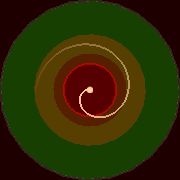
In the green zone there are stable circular orbits and it is safe to stay here.
In the yellow zone, circular orbits are unstable, and the slightest engine maneuver can lead to a fall into a black hole, or to fly out.
In the orange zone there are no circular orbits, and if you want to get out of there, you have the only chance - to burn your rockets with might and main.
The red line is the event horizon. If you cross it, nothing will help to get back.

The clock in the lower right corner counts the time to reach the central singularity. The clock shows the time from the point of view of the falling observer, and in this video the clock slows down not because of relativistic effects , but simply to make it easier to view the most interesting events occurring at the end.
Time is measured in seconds for a black hole with a mass of 5 million solar masses, similar to that located in the center of the Galaxy. After crossing the horizon of such a black hole, you will have only 16 seconds to reach the singularity.
Of course, in reality, there is no burgundy grid on the horizon of the black hole event, and the horizon crossing passes unnoticed by the adventurer, as can be seen by viewing the “blank” video. Approaching the black hole, you can see the “north” and “south” poles at the same time due to the curvature of light.
The background is a panorama of the Milky Way by Axel Mellinger.

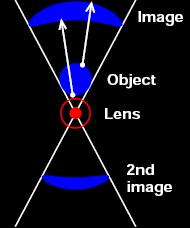
A black hole, like any massive object, bends the light passing by it, so that one object creates several images. The closer to the black hole, the more strongly the rays are bent, so that the picture is compressed in the radial direction.
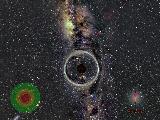
If the object is exactly behind the black hole, a beautiful effect arises - the Einstein ring.

At a distance of 3 Schwarzschild radii is the last stable circular orbit. Above, we could still rotate around a black hole, like a planet around the sun and not worry about anything.
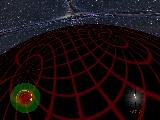
At a distance of 1.5 Schwarzschild radius, we intersect the photon sphere - here the photons could, moving at the speed of light, rotate around the black hole indefinitely. In fact, we will not see anything interesting here, because these orbits are unstable.
Since we are massive creatures, we cannot accelerate to the speed of light. But if we had accelerated to a speed close to the speed of light, and went into a circular orbit just above the photon sphere, we would see something like this: (animated gif, 7MB)
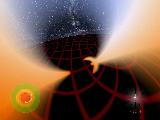
When you fall beyond the event horizon at 1 Schwarzschild radius, strange things happen. It would seem that you have to cross the burgundy grid, but it remains in front of you. And the horizon in front of you is falling apart into two parts.
Without a grid, you would not even notice that you have failed beyond the horizon.
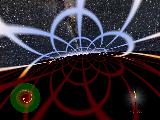
The closer to the singularity, the more tidal forces act on you. On your heels (if you fall forward with your feet) there is a large gravitational force than on your head, so that you stretch in the vertical direction is a good way to become taller and lose weight, but very short-lived. About a second before the singularity, it will simply tear you apart.
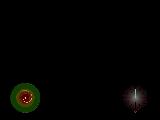
In this strange place, at a point of infinite curvature, our ideas about space-time end.
All pictures and most of the original text were created by Prof. Andrew Hamilton. The original can be found here . The site is still heavily under development, so it makes sense to come back later and learn something new.
Upd: Of course, in this video, quantum effects like Hawking radiation are not taken into account, and the black hole is considered to be quite remote from large clusters of matter, so we don’t see accretion disks , jets and other fireworks.
Medium quality: 640 × 480 mpeg4 (10MB)
High quality: 640 × 480 quicktime (84MB)
The same video, but without a map, clock and grid:
General theory of relativity
Almost a century has passed since Albert Einstein proposed the general theory of relativity in 1915. Black holes are one of the most extreme predictions of this theory. Now astronomers have found numerous confirmations of the existence of black holes. Of course, no one saw the black holes themselves, because they do not radiate, but the mockery they cause of matter and the space-time itself is quite noticeable.
')
The black hole has no hair
Any black hole for an observer outside can be described with just three parameters:
- weight
- electric charge
- spin
This is probably the simplest object in the universe - they are much simpler than stars and planets, and much simpler than humans.
We will fall into the simplest black hole, which has no electric charge and spin. This solution to the Einstein equation was found by Schwarzschild just a few weeks after the publication of the theory.
Map

In the green zone there are stable circular orbits and it is safe to stay here.
In the yellow zone, circular orbits are unstable, and the slightest engine maneuver can lead to a fall into a black hole, or to fly out.
In the orange zone there are no circular orbits, and if you want to get out of there, you have the only chance - to burn your rockets with might and main.
The red line is the event horizon. If you cross it, nothing will help to get back.
Clock

The clock in the lower right corner counts the time to reach the central singularity. The clock shows the time from the point of view of the falling observer, and in this video the clock slows down not because of relativistic effects , but simply to make it easier to view the most interesting events occurring at the end.
Time is measured in seconds for a black hole with a mass of 5 million solar masses, similar to that located in the center of the Galaxy. After crossing the horizon of such a black hole, you will have only 16 seconds to reach the singularity.
Grid
Of course, in reality, there is no burgundy grid on the horizon of the black hole event, and the horizon crossing passes unnoticed by the adventurer, as can be seen by viewing the “blank” video. Approaching the black hole, you can see the “north” and “south” poles at the same time due to the curvature of light.
Background
The background is a panorama of the Milky Way by Axel Mellinger.
Gravity lensing


A black hole, like any massive object, bends the light passing by it, so that one object creates several images. The closer to the black hole, the more strongly the rays are bent, so that the picture is compressed in the radial direction.

If the object is exactly behind the black hole, a beautiful effect arises - the Einstein ring.
Finally we fall!
Last steady orbit

At a distance of 3 Schwarzschild radii is the last stable circular orbit. Above, we could still rotate around a black hole, like a planet around the sun and not worry about anything.
Photon sphere

At a distance of 1.5 Schwarzschild radius, we intersect the photon sphere - here the photons could, moving at the speed of light, rotate around the black hole indefinitely. In fact, we will not see anything interesting here, because these orbits are unstable.
Since we are massive creatures, we cannot accelerate to the speed of light. But if we had accelerated to a speed close to the speed of light, and went into a circular orbit just above the photon sphere, we would see something like this: (animated gif, 7MB)
Falling beyond the horizon

When you fall beyond the event horizon at 1 Schwarzschild radius, strange things happen. It would seem that you have to cross the burgundy grid, but it remains in front of you. And the horizon in front of you is falling apart into two parts.
Without a grid, you would not even notice that you have failed beyond the horizon.
Tearing apart

The closer to the singularity, the more tidal forces act on you. On your heels (if you fall forward with your feet) there is a large gravitational force than on your head, so that you stretch in the vertical direction is a good way to become taller and lose weight, but very short-lived. About a second before the singularity, it will simply tear you apart.
AAAAAAAA! Singularity!

In this strange place, at a point of infinite curvature, our ideas about space-time end.
Thanks
All pictures and most of the original text were created by Prof. Andrew Hamilton. The original can be found here . The site is still heavily under development, so it makes sense to come back later and learn something new.
Upd: Of course, in this video, quantum effects like Hawking radiation are not taken into account, and the black hole is considered to be quite remote from large clusters of matter, so we don’t see accretion disks , jets and other fireworks.
Source: https://habr.com/ru/post/56427/
All Articles